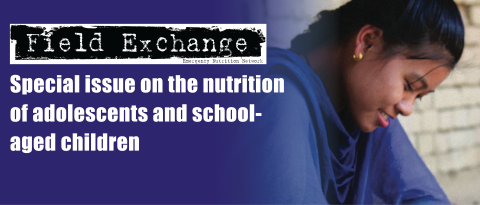Growth through Nutrition: The Adolescent Nutrition SBCC Program in Ethiopia
Save the Children (2019). Documenting Research on the USAID Growth through Nutrition Activity Adolescent Nutrition SBCC Program: Outcomes and Lessons Learned. Available here.
The Adolescent Nutrition Social Behavioural Change Communication (SBCC) Program is just one component of Growth through Nutrition, a multi-sector nutrition project in Ethiopia, initiated in 2019 in 20 woredas (districts) in Tigray, Amhara, Oromia and Southern Nations, Nationalities and Peoples Region (SNNPR). The Adolescent Nutrition SBCC Program currently uses pre-tested, nutrition awareness-raising1 , nutrition knowledge2 and skills-building3 SBCC materials in school-based clubs and other community platforms where adolescents and their families are reached. In addition, adolescent nutrition education radio spots are broadcast in classrooms. The ‘star food’ concept was introduced across SBCC materials; the concept supports communication about priority nutrient-rich foods to improve dietary diversity.
This report details the early, rapid assessment of the Adolescent Nutrition SBCC Program to identify strengths, weaknesses and opportunities for improvements. The study consisted of 11 focus group discussions (FGD) with primary, secondary and out-of-school adolescents, 16 individual and small group interviews with mothers and fathers, in- and out-of-school adolescents, nutrition programme facilitators, educational radio personnel, regional SBCC managers and one direct observation. One woreda from each intervention region was chosen; these were randomly selected from Amhara, Oromia and SNNPR. Neadir Adet woreda from Tigray was purposefully chosen as it contains both food secure and food insecure areas.
The assessment found schoolteachers had been trained in all four regions. In SNNPR and Tigray, SBCC managers were also training education officers and health staff while in SNNPR, Amhara and Oromia SBCC managers were training out-of-school programme facilitators. Trained teachers had introduced adolescent nutrition activities into existing gender or health clubs or had created nutrition clubs. Adolescents reported high satisfaction with these clubs and felt the information provided had been previously lacking. They appreciated being able to borrow materials such as games. However, not all adolescents were provided with other materials such as leaflets to take home due to fear of shortages.
Overall, the Adolescent Nutrition SBCC materials appear to be well-received, understood and used with regions tailoring activities to suit their context. Almost all FGD participants said they had shared the nutrition information gained from the clubs with their parents. Adolescents and parents also reported changes in behaviours such as adding a vegetable or protein to breakfast. Topics such as dietary diversity seemed to be well assimilated. However, some topic areas such as nutrition during menstruation and gender were much less mentioned by adolescents, suggesting a need for a greater emphasis on these topics moving forward. The role of radio was yet to be optimised as none of the primary school students had heard a nutrition radio spot and radio staff expressed the need for a mechanism to assess and maximise listenership. Valid concerns exist about the need for further evidence of a change in nutritional and nutrition-sensitive practices, sustaining interest in improving adolescent nutrition and the ability of the programme to help adolescents and families to overcome resource-related impediments to good nutrition. Several opportunities exist for the programme to begin to address these issues and to improve in other areas moving forward.
1 Materials include girls’ “Bright Minds, Bright Futures” poster and “Five Household Doable Actions for Girls and Boys” poster.
2 Materials include the “Nutrition Practices Card Game”, the “Best Nutrition Secrets to Share” Conversation Leaflet for girls and the “Nutrition Hookworms and Ladders” Game.
3 Materials include the Menu Planning game and the Earn and Buy game.


 English
English Français
Français Deutsch
Deutsch Italiano
Italiano Español
Español